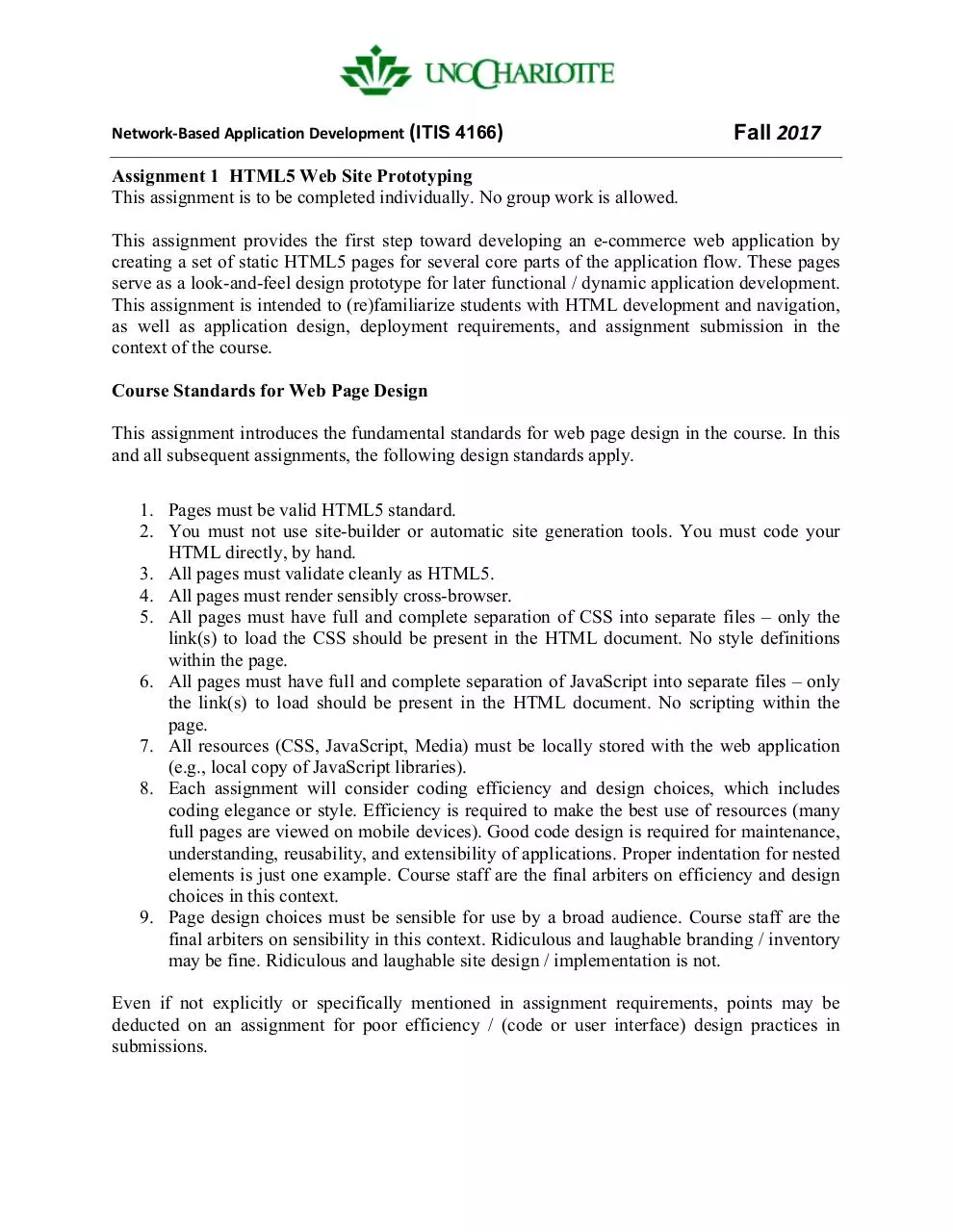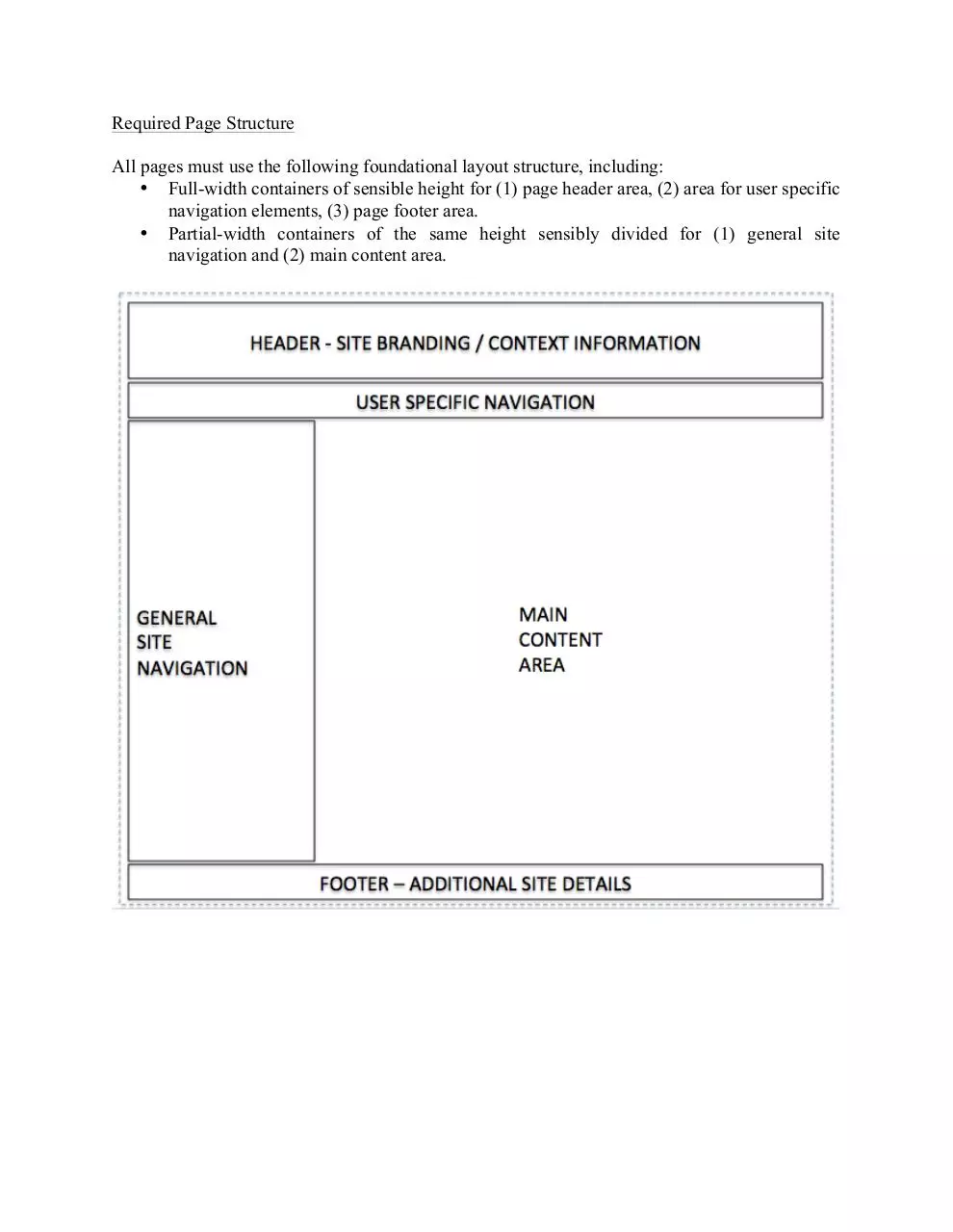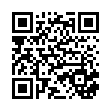ITIS4166 A1 (PDF)
File information
Title: Microsoft Word - 1.docx
This PDF 1.6 document has been generated by Word / Mac OS X 10.9.4 Quartz PDFContext, and has been sent on pdf-archive.com on 15/09/2017 at 18:07, from IP address 198.86.x.x.
The current document download page has been viewed 396 times.
File size: 526.08 KB (8 pages).
Privacy: public file





File preview
Network-Based Application Development (ITIS 4166)
Fall 2017
Assignment 1 HTML5 Web Site Prototyping
This assignment is to be completed individually. No group work is allowed.
This assignment provides the first step toward developing an e-commerce web application by
creating a set of static HTML5 pages for several core parts of the application flow. These pages
serve as a look-and-feel design prototype for later functional / dynamic application development.
This assignment is intended to (re)familiarize students with HTML development and navigation,
as well as application design, deployment requirements, and assignment submission in the
context of the course.
Course Standards for Web Page Design
This assignment introduces the fundamental standards for web page design in the course. In this
and all subsequent assignments, the following design standards apply.
1. Pages must be valid HTML5 standard.
2. You must not use site-builder or automatic site generation tools. You must code your
HTML directly, by hand.
3. All pages must validate cleanly as HTML5.
4. All pages must render sensibly cross-browser.
5. All pages must have full and complete separation of CSS into separate files – only the
link(s) to load the CSS should be present in the HTML document. No style definitions
within the page.
6. All pages must have full and complete separation of JavaScript into separate files – only
the link(s) to load should be present in the HTML document. No scripting within the
page.
7. All resources (CSS, JavaScript, Media) must be locally stored with the web application
(e.g., local copy of JavaScript libraries).
8. Each assignment will consider coding efficiency and design choices, which includes
coding elegance or style. Efficiency is required to make the best use of resources (many
full pages are viewed on mobile devices). Good code design is required for maintenance,
understanding, reusability, and extensibility of applications. Proper indentation for nested
elements is just one example. Course staff are the final arbiters on efficiency and design
choices in this context.
9. Page design choices must be sensible for use by a broad audience. Course staff are the
final arbiters on sensibility in this context. Ridiculous and laughable branding / inventory
may be fine. Ridiculous and laughable site design / implementation is not.
Even if not explicitly or specifically mentioned in assignment requirements, points may be
deducted on an assignment for poor efficiency / (code or user interface) design practices in
submissions.
Assignment Description:
In this assignment you will develop four HTML pages, according to the following specifications.
1. Choose an e-commerce area of interest to you. You must develop your own unique site
with branding, categories, and items representative of that area. Creativity is encouraged.
2. You are not allowed to select previously created branding / content. You must create your
own. In particular, you must not use any branding / content from (1) the assignment
itself; (2) the textbook; or (3) any other students in any of the sections of the course.
3. Each of the pages specified must be a standalone, individual HTML page. And not, for
example, framed or one single page with main content section visibility switching.
4. Each of the pages must be standalone, but must have a common design to preserve the
look-and-feel of the site. So, some of the common look-and-feel elements will be
repeated across pages. Common look-and-feel elements must render exactly the same, so
there are seamless transitions with no jitter between pages for common elements.
5. You must conform to the required overall page layout structure.
6. Within each of the sections of the overall page layout structure, you may style the content
differently than the representative examples (color scheme, alignment, etc.), as long as
the illustrated types of content are present and represented in a reasonable and
understandable way.
7. All of the content must be represented using HTML directly (no JavaScript DOM
generation).
8. For this assignment, we will consider the following specific design standard
requirements:
a. Validation of HTML5 by the following tool: http://html5.validator.nu/
b. Cross-browser checking for Firefox and Chrome
Required Page Structure
All pages must use the following foundational layout structure, including:
• Full-width containers of sensible height for (1) page header area, (2) area for user specific
navigation elements, (3) page footer area.
• Partial-width containers of the same height sensibly divided for (1) general site
navigation and (2) main content area.
Page 1 – Home Page
Common content elements described here (navigation, header, footer) also apply to the other
pages. This page should provide the following content / functionality:
• Filename: index.html
• Logo / primary branding in the header
• Placeholder for login name
• Breadcrumb for current place in site structure
• Representative links for user-specific navigation (sign-in, cart, my orders, etc.)
o Cart link must provide navigation to cart page
• Representative links for general site navigation (home, catalog, about, etc.)
o Catalog link must provide navigation to catalog page
o Home link must link to home page
• Representative footer information (copyright, etc.)
• Main content area should provide an introduction and overview to the site. May be more
than simply text
Page 2 – Catalog Page
This page should provide the following content / functionality in addition to common content:
• Filename: catalog.html
• At least two categories of items
• At least three items per category
• All item listings should link to the same item page, as a design placeholder
• Note that within the main content container, catalog organization may be fancier than a
plain list (e.g., dropdown category select box driving item display)
Page 3 – Item Detail
This page should provide the following content / functionality in addition to common content:
(Note: only one item page is needed as a representative page – not a different one for every item
in the catalog list)
• Filename: item.html
• Picture of item
• Item highlights, including category and price
• Item detail description
• Button to add the item to the shopping cart
o Button action should link to the shopping cart page
Page 4 – Shopping Cart
This page should provide the following content / functionality in addition to common content:
• Filename: cart.html
• Main content container should provide a table structure listing representative items,
quantities (> 0), prices, and totals, and overall subtotal.
• At least two items with different quantities should be represented
• Quantities should be values within input field elements (should be able to change the
values)
• Update cart button action should link to the cart page
• Checkout button should link to the catalog page
Assignment Submissions
What to submit using Canvas (Email submissions will NOT be accepted):
1. hw1.war - An archive of the entire web application (project) stored in a standard WAR
file. Though there are only HTML pages for this assignment, part of the exercise is to go
through the steps of creating and submitting such archives. Note that while there are no
java sources for this assignment, but when there are, you must ensure that the java source
files are included as part of the archive. The WAR file will be imported into Netbeans for
grading and may be required to be deployed as part of the submission.
2. info.pdf – PDF document with the following assignment information :
a) Explanation of status and stopping point, if incomplete.
b) Explanation of additional features, if any.
c) Discuss the easy and challenging parts of the assignment. How did you overcome
all or some of the challenges?
Download ITIS4166 A1
ITIS4166_A1.pdf (PDF, 526.08 KB)
Download PDF
Share this file on social networks
Link to this page
Permanent link
Use the permanent link to the download page to share your document on Facebook, Twitter, LinkedIn, or directly with a contact by e-Mail, Messenger, Whatsapp, Line..
Short link
Use the short link to share your document on Twitter or by text message (SMS)
HTML Code
Copy the following HTML code to share your document on a Website or Blog
QR Code to this page

This file has been shared publicly by a user of PDF Archive.
Document ID: 0000674040.